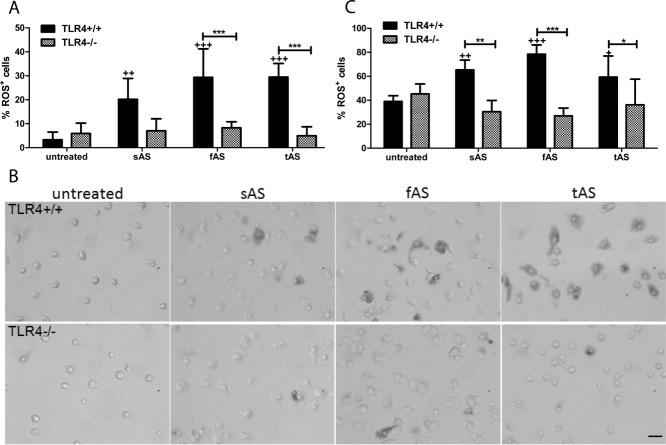Figure 4.
TLR4 ablation results in a reduction of ROS production by glial cells after exposure to AS. Primary murine microglial and astroglial cells were treated with different AS forms (full length soluble AS–sAS, fibrillized AS–fAS, and C-terminally truncated AS–tAS). Nitroblue tetrazolium chloride was added to visualize ROS production. Cells were fixed with 4% paraformaldehyde and ROS-positive cells were counted using an inverse microscope. A: Treatment with all AS-forms led to an enhanced ROS release by TLR4+/+ microglia. TLR4 deficient microglia showed a reduced production of ROS in comparison to TLR4+/+ microglia. Data were analyzed by two-way ANOVA with post-hoc Bonferroni test. Results are presented as mean ± S.D. +++ P < 0.001, ++ P < 0.01 compared with untreated TLR4+/+ microglia, ***P < 0.001 comparison of TLR4+/+ to TLR4−/− microglia. n = 3 (excl. untreated TLR4+/+ and TLR4−/− microglia n = 5). B: Light microscopy of microglia visualizing the difference of ROS production by TLR4+/+ and TLR4−/− microglia (scale bar, 10 μm). C: Treatment with all AS forms initiated augmented ROS production by TLR4+/+ astroglia, whereas, TLR4 ablated astroglia showed a decreased ROS production in comparison to TLR4+/+ astroglia. Data were analyzed by two-way ANOVA with post-hoc Bonferroni test. Results are presented as mean ± S.D. +++ P < 0.001, ++ P < 0.01, + P < 0.05 compared with untreated TLR4+/+ astroglia, ***P < 0.001, **P < 0.01, *P < 0.05 comparison of TLR4+/+ to TLR4−/− microglia n = 3.

